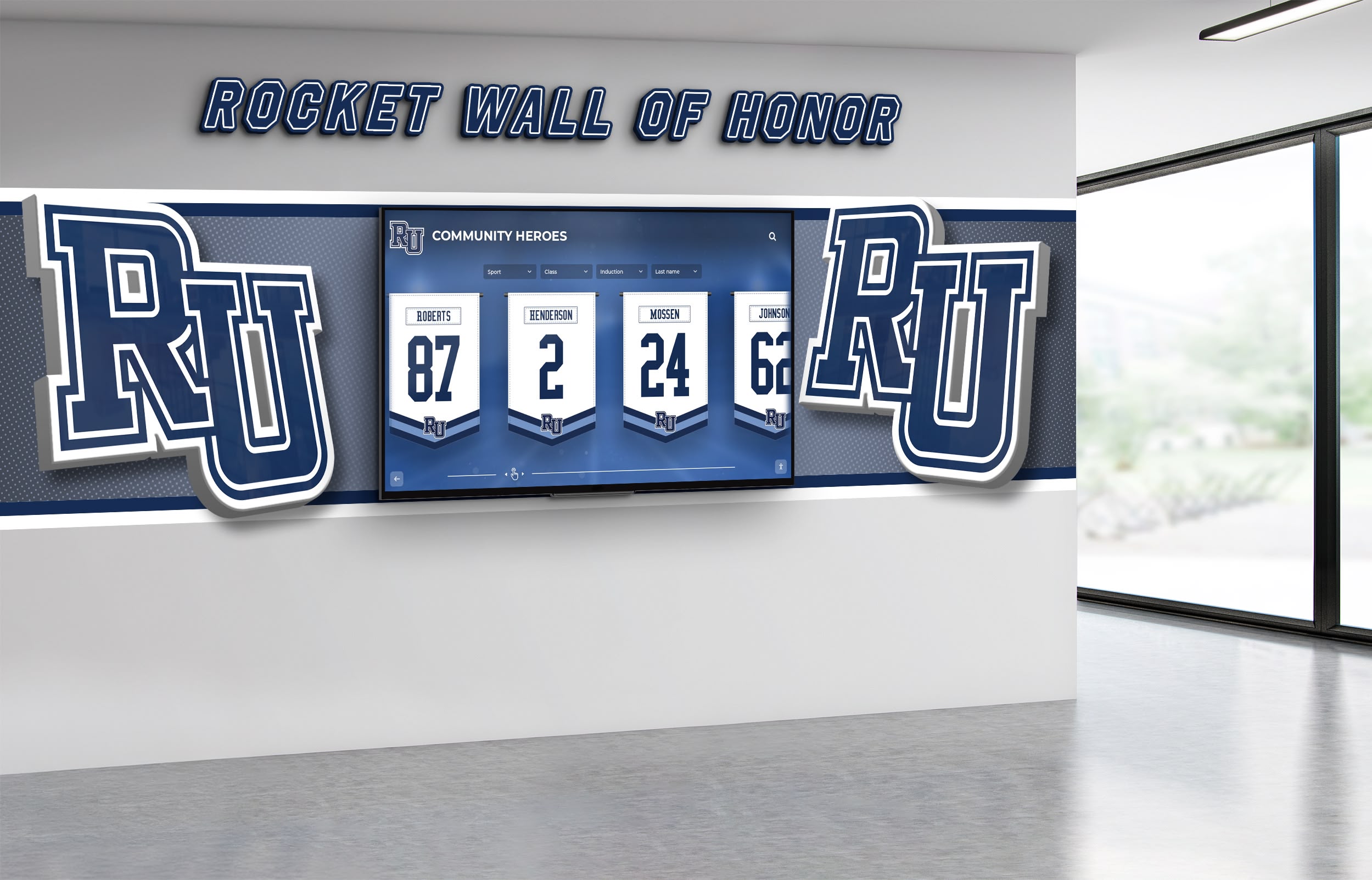Walk into almost any school’s storage closet, and you’ll find the same heartbreaking scene: stacks of championship trophies gathering dust, state tournament plaques wrapped in plastic, district titles shoved onto forgotten shelves, and conference recognition pieces sitting in cardboard boxes. These aren’t minor participation awards—they’re significant achievements representing countless hours of dedication, memorable victories, and proud moments in school history. Yet here they sit, invisible and forgotten, providing zero recognition value to the students who earned them or those who could be inspired by them.
The problem isn’t that schools don’t value these accomplishments. Athletic directors, principals, and coaches fully understand what each trophy represents. The issue is simpler and more frustrating: there’s simply not enough space in traditional trophy cases to display everything a successful program accumulates over decades of excellence.
Digital recognition displays solve this fundamental problem by bringing every trophy out of hiding—not by replacing physical awards, but by ensuring comprehensive visibility through interactive touchscreen systems that showcase unlimited achievements with rich context and engaging presentations impossible with traditional cases.
Understanding the Storage Trophy Problem
Before exploring solutions, it’s important to understand exactly how schools end up with more trophies in storage than on display, and why this problem only worsens over time.
The Mathematics of Trophy Accumulation
Successful athletic programs generate awards at rates that quickly overwhelm physical display capacity. Consider a typical scenario at a comprehensive high school:
Annual Trophy Generation:
- 15-20 varsity sports programs
- Conference championships: 3-5 per year
- District/regional championships: 2-4 per year
- State championships: 1-2 per year
- Individual achievement awards: 10-20 per year
- Coach recognition and milestones: 2-5 per year
- Special tournaments and invitationals: 5-10 per year
Total new trophies annually: 23-46
Over just 10 years, that’s 230-460 trophies. Over 20 years, 460-920 trophies. Over 30 years—a reasonable span for many established programs—that’s 690-1,380 trophies requiring display space.
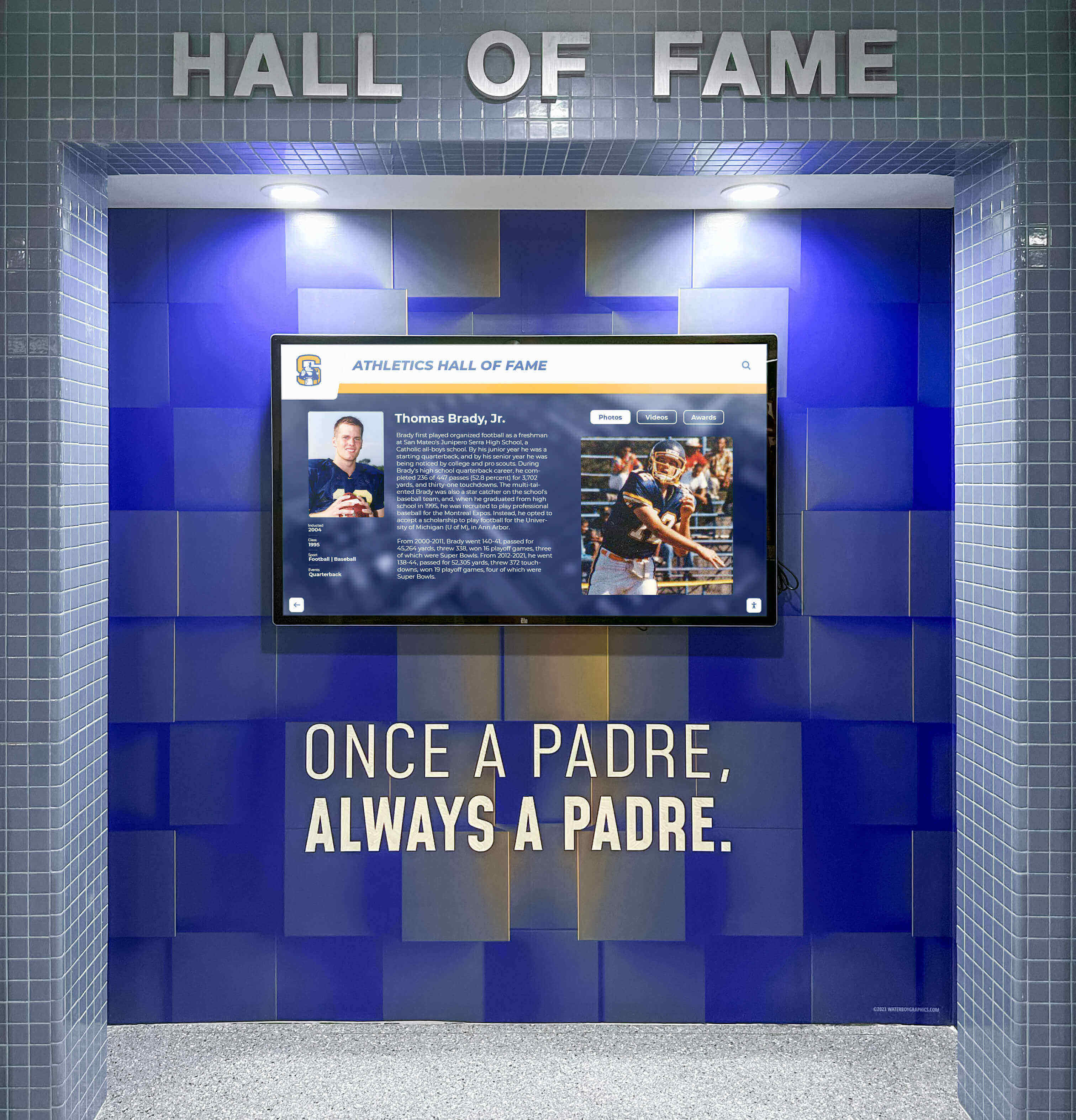
Now compare that accumulation to display capacity:
Typical Trophy Case Capacity:
- Standard 6-foot glass-fronted trophy case: 25-35 trophies
- Large 8-foot case with multiple shelves: 40-50 trophies
- Schools typically have 2-6 cases total: 100-250 trophy capacity
The math is brutal and unavoidable. Even schools with generous trophy case installations can display only a fraction of actual achievements, forcing difficult decisions about what receives visibility and what disappears into storage.
Why Some Trophies End Up Hidden
The selection of which trophies remain displayed versus which go to storage rarely reflects achievement importance. Instead, practical factors drive these decisions:
Physical Size Dominates
Large championship trophies consume disproportionate space regardless of their relative significance. A three-foot football state championship trophy occupies as much space as six smaller awards from other sports. This creates unintentional hierarchies where sports with larger trophies receive more visibility simply due to object size.
Recent Bias Prevails
As new achievements arrive, older trophies move to storage to make room, creating recency bias where only recent years receive recognition. A basketball program’s 1990s state championships disappear from view despite representing the same elite achievement as current titles. Alumni visiting campus find their accomplishments gone, replaced by newer teams’ awards.
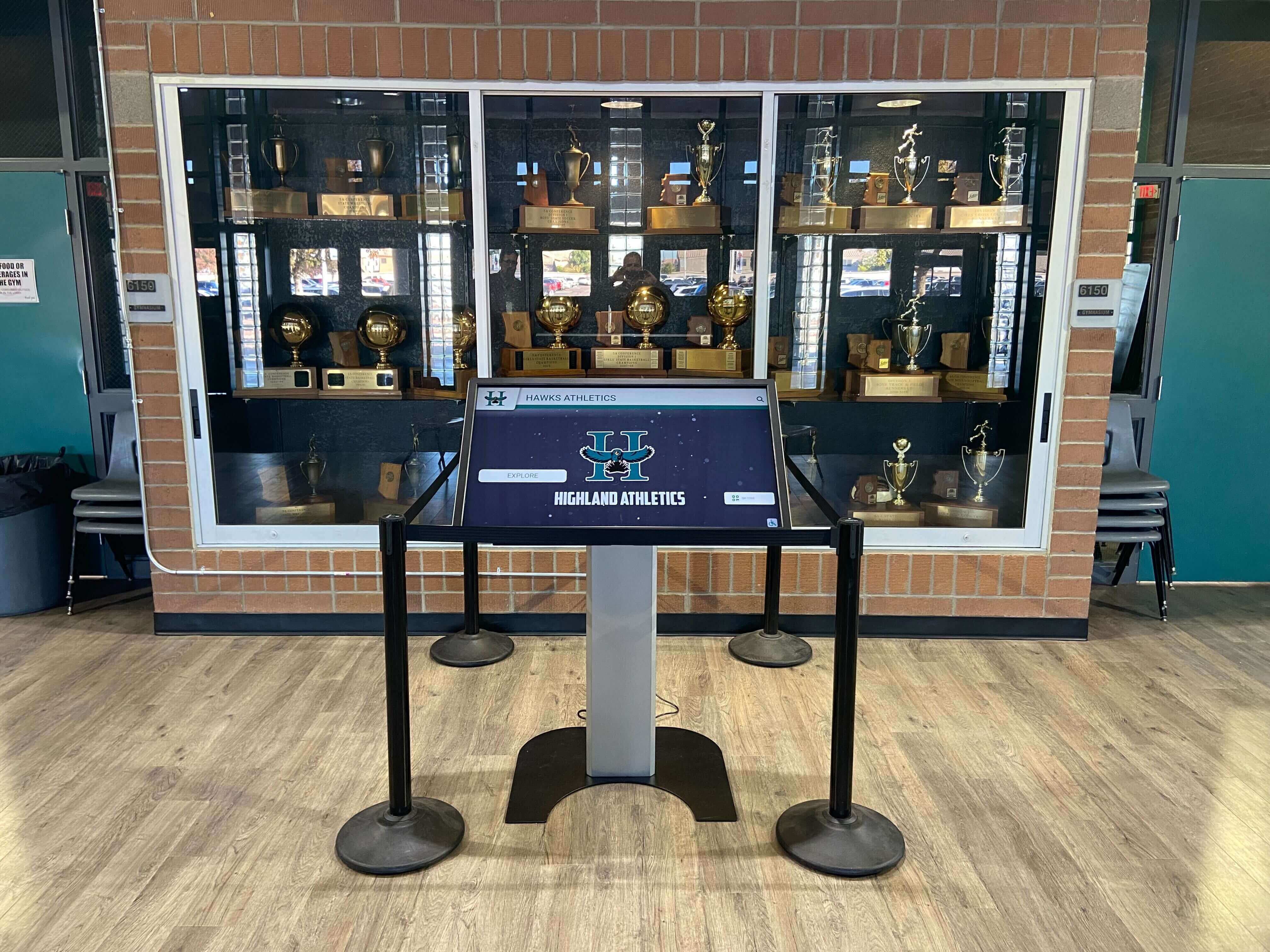
Sport-Specific Space Competition
Programs with sustained success and consistent trophy generation eventually dominate limited case space. A football program winning 30 trophies over a decade might claim entire cases, leaving successful but less trophy-heavy programs like tennis, golf, or swimming with minimal representation regardless of actual achievement quality.
Administrative Burden of Rotation
Updating trophy cases requires physical work—unlocking cases, removing items, rearranging remaining trophies, installing new plaques, and relocking cases. This labor-intensive process means updates happen infrequently, and once trophies move to storage, they rarely return to display even when newer items could reasonably be rotated out.
The Real Cost of Hidden Trophies
When trophies disappear into storage, the consequences extend far beyond simple invisibility:
Lost Inspiration for Current Athletes
Student-athletes find motivation in seeing what previous teams accomplished. Championship traditions and visible recognition create aspirational goals and program standards. When those achievements sit hidden, current athletes lose access to program history that could inspire their own excellence.
Diminished Alumni Connection
Alumni who return to campus expect to see their achievements still recognized and valued. Discovering that their championship trophy has been relegated to storage—even when this reflects space constraints rather than value judgments—feels like their accomplishments have been forgotten or devalued. This weakens emotional connections that support ongoing alumni engagement and giving.
Incomplete Recruitment Picture
Prospective student-athletes and their families evaluate programs partially through visible achievement displays. When space limitations prevent schools from showcasing complete competitive histories, programs may appear less successful than they actually are. Digital trophy displays solve this by providing comprehensive achievement visibility that accurately represents program excellence.
Wasted Recognition Investment
Schools invest $2,000-$5,000 annually on trophies, plaques, and awards. When most of these items provide value only during initial award ceremonies before moving to storage, that investment generates minimal ongoing return. The initial expense remains the same, but recognition value drops to zero once items disappear from view.
How Digital Displays Rescue Storage Trophies
Digital recognition systems don’t require discarding physical trophies or completely replacing traditional cases. Instead, they complement existing displays by ensuring comprehensive visibility for every achievement regardless of physical storage location.
Unlimited Capacity Ends Storage Necessity
The most immediate benefit of digital displays addresses the core problem: unlimited recognition capacity eliminates the need for trophy storage due to space constraints.
A single touchscreen installation can showcase thousands of detailed achievement profiles including:
- High-resolution photos of every trophy from multiple angles
- Complete team rosters with individual athlete information
- Season statistics and game-by-game results
- Championship game highlights and memorable moments
- Coach profiles and career accomplishments
- Context about competition level and historical significance
This capacity transforms the trophy management equation entirely. Instead of asking “Which 200 of our 800 trophies deserve display space?” schools can ask “How do we best organize and present all 800 achievements to maximize engagement and inspiration?”

Systematic Trophy Documentation Process
Bringing storage trophies into digital recognition requires systematic documentation, but the process is straightforward and the results are permanent:
Trophy Photography
Take storage trophies out temporarily for professional documentation:
- Clean each trophy thoroughly for best presentation
- Photograph from multiple angles with consistent lighting
- Capture close-ups ensuring engraving details are legible
- Document trophy size and construction for context
- Return items to storage after photography
Information Extraction
Record all available details while trophies are accessible:
- Championship level and competition name
- Year won and specific dates when available
- Team roster or individual recipients
- Season record and tournament results
- Coach names and career context
- Any special historical significance
Supplemental Research
Enhance basic trophy information with contextual content:
- Yearbook photos of teams and individuals
- Newspaper clippings covering championships
- Game programs or bracket sheets
- Team photos from season or award ceremonies
- Alumni memories and reflections when available
This documentation preserves achievement information permanently in digital form. Once completed, physical trophies can remain safely in storage while their digital representations provide full visibility and recognition value.
Hybrid Approaches Maximizing Value
Most successful implementations combine selective physical displays with comprehensive digital recognition:
Showcase Physical Centerpieces
Maintain limited traditional displays featuring:
- The most historically significant championships
- State-level titles representing peak achievement
- Milestone trophies marking program anniversaries
- Retired jerseys and hall of fame plaques
- Current year championships celebrating recent success
Provide Digital Completeness
Use touchscreen systems to showcase:
- Every championship from program history
- Conference and district titles of all levels
- Individual achievement awards and records
- Tournament participation and playoff appearances
- Special recognition and milestone celebrations
This hybrid approach honors traditional trophy case value while ensuring nothing remains permanently hidden. Museums and cultural institutions use similar approaches to balance limited physical space with comprehensive collection accessibility.
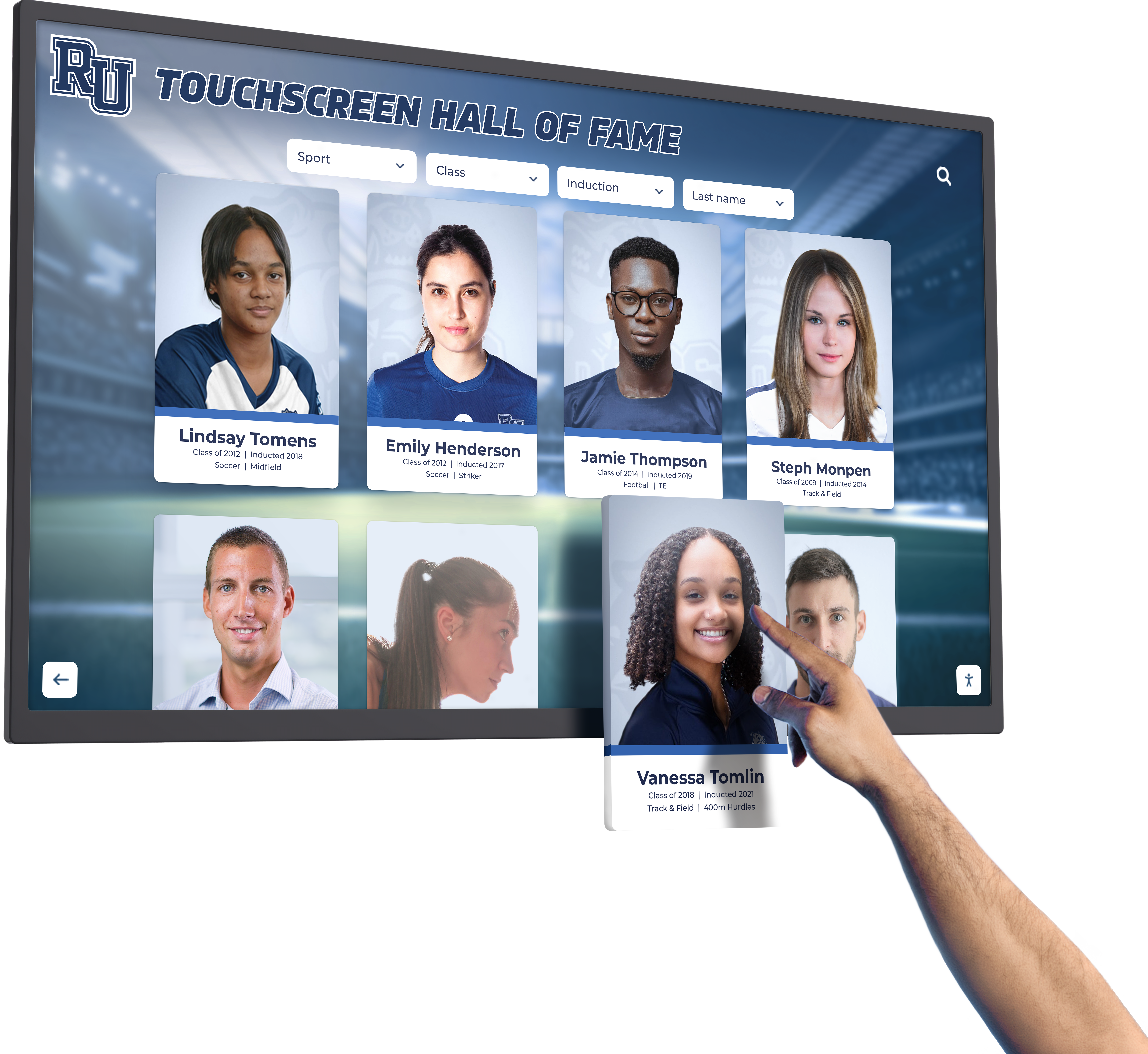
Creating Compelling Digital Achievement Profiles
Simply photographing storage trophies and adding basic labels doesn’t maximize recognition value. Effective digital profiles tell complete stories:
Rich Context Transforms Trophies into Narratives
For a 1995 basketball state championship trophy currently in storage:
Basic Recognition: “1995 Boys Basketball State Champions”
Comprehensive Digital Profile includes:
- Trophy photographs from all angles
- Complete team roster with player photos
- Season record and tournament path to championship
- Championship game score and key statistics
- Coach profile and career context at that point
- Notable players and post-high school achievements
- Newspaper coverage and community reaction
- Video highlights if available from archives
- Reflections from team members decades later
- Connections to other program championships
This transformation turns a physical object gathering dust into an engaging achievement story that inspires current students and reconnects alumni with meaningful memories.
Search and Discovery Features
Digital systems enable visitors to find specific achievements instantly:
- Name search: Alumni can find every trophy featuring them
- Year filters: Browse championships by decade or specific years
- Sport categories: Explore all achievements in particular sports
- Achievement level: View state championships separately from district titles
- Keyword search: Find specific tournaments or competitions
This searchability ensures storage trophies become more accessible digitally than they ever were physically, even when they occupied premium display space.
Implementation: Bringing Your Storage Trophies to Light
Schools ready to restore visibility to hidden trophies benefit from systematic implementation approaches ensuring success and sustainability.
Phase 1: Assessment and Planning (Weeks 1-2)
Inventory Storage Collections
Document what currently sits hidden:
- Catalog all trophies in storage rooms and closets
- Note athletic office displays not in public cases
- Identify awards at off-site storage facilities
- Count items by sport, decade, and achievement level
- Assess trophy condition and preservation needs
This inventory reveals the full scope of hidden recognition and helps prioritize digitization efforts.
Define Recognition Goals
Clarify what comprehensive recognition should accomplish:
- Honor all athletes and achievements equitably across sports
- Provide inspiration for current student-athletes
- Reconnect alumni with their achievements
- Demonstrate program excellence to prospective athletes
- Preserve institutional history and tradition
- Create pride throughout school community
Clear goals guide subsequent decisions about content presentation, system features, and success measurement.
Budget and Resource Planning
Determine available investment and implementation timeline:
Hardware investment: $12,000-$40,000 depending on display size and configuration Software subscription: $1,500-$6,000 annually for comprehensive platforms Content development: $2,000-$8,000 for professional photography and data entry Installation: $1,500-$5,000 for professional mounting and configuration
Many schools fund implementations through booster clubs, alumni giving, corporate sponsorships, or capital campaigns emphasizing that investments restore recognition to hundreds of currently hidden achievements.
Phase 2: Content Development (Weeks 3-8)
Systematic Trophy Documentation
Approach storage collections methodically:
Week 3-4: Document most recent 10 years (typically 200-400 trophies) Week 5-6: Photograph 10-20 years back (next 200-400 trophies) Week 7-8: Capture historical achievements (remaining older items)
This phased approach allows launching displays with recent content while continuing historical documentation over time.
Efficient Photography Setup
Create consistent, professional results:
- Establish permanent photo station with backdrop and lighting
- Use smartphone cameras with adequate resolution (12MP+)
- Maintain consistent angles and framing across all trophies
- Photograph in batches to maintain efficiency
- Immediately organize files with consistent naming
Data Entry and Organization
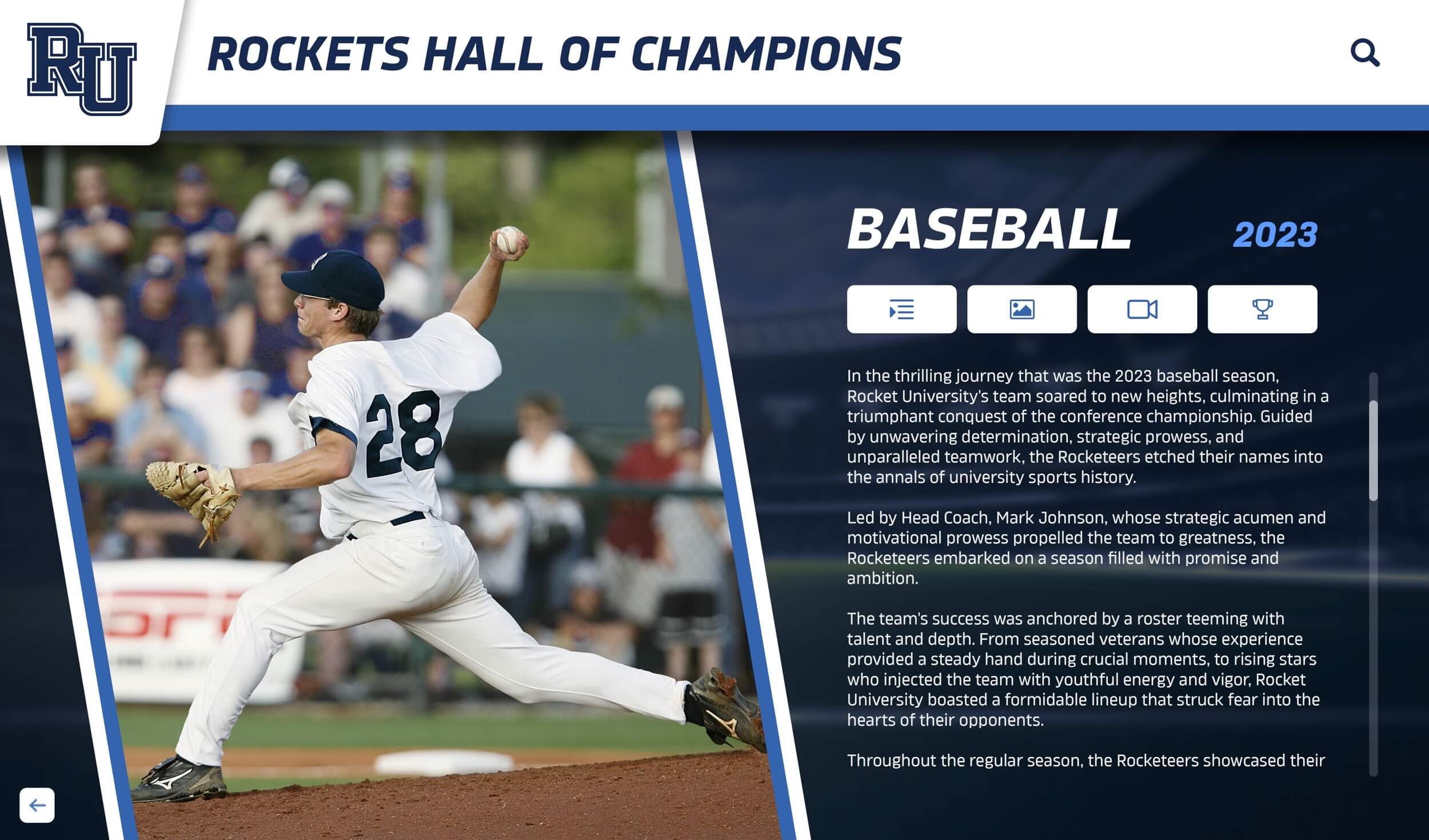
Develop structured content for each achievement:
- Enter all engraved information exactly as shown
- Add contextual details from research
- Tag content with appropriate categories
- Link related achievements and athletes
- Include supplemental photos and documents
Comprehensive content management processes ensure quality and consistency across large trophy collections while maintaining efficient workflow.
Phase 3: Platform Setup and Display Installation (Weeks 9-10)
Software Configuration
Set up digital recognition platform:
- Configure categories matching your organization
- Establish user accounts and access permissions
- Upload prepared content in batches
- Test search and filtering functionality
- Customize visual design with school branding
Hardware Installation
Position displays for maximum visibility and engagement:
- Main athletic facility entrance for all traffic
- Gymnasium lobby for event attendance
- Training facilities where athletes spend daily time
- Cafeteria or commons areas for extended viewing
Professional installation ensures secure mounting, clean cable management, and reliable operation. Solutions like Rocket Alumni Solutions often include installation coordination as part of service packages.
Staff Training
Ensure sustainable operations:
- Train athletic directors and support staff on content updates
- Document procedures for adding new achievements
- Establish workflows for ongoing maintenance
- Create reference materials for troubleshooting
- Designate primary and backup administrators
Phase 4: Launch and Community Engagement (Week 11+)
Celebratory Unveiling
Create excitement around restored recognition:
- Schedule unveiling during homecoming or high-attendance event
- Invite alumni whose achievements are newly visible
- Demonstrate interactive features and search capabilities
- Generate media coverage highlighting the transformation
- Share on social media with engaging content
- Integrate into campus tours and recruitment activities
Ongoing Content Enhancement
Continue improving recognition over time:
- Add newly awarded achievements promptly
- Enhance historical content as information emerges
- Respond to alumni who provide photos and memories
- Feature rotating highlights showcasing different eras
- Monitor analytics to understand engagement patterns
Addressing Common Concerns About Storage Trophies
Schools considering comprehensive digital recognition frequently raise similar questions about process, costs, and physical trophy handling.
“What happens to physical trophies once digitized?”
Digital documentation doesn’t require destroying or discarding physical awards. Schools take various approaches:
Maintain Secure Storage
Many schools keep physical trophies in organized storage:
- Climate-controlled spaces preventing deterioration
- Properly labeled and organized by sport and year
- Available for special exhibitions or milestone events
- Protected from damage while digitally accessible
Return to Award Recipients
Offer individual and team trophies back to those who earned them:
- Host trophy pickup events during reunions
- Contact alumni to claim their personal awards
- Generate positive engagement and goodwill
- Reduce storage needs while honoring achievements
Create Selective Physical Displays
Rotate physical trophies seasonally:
- Display current sport season championships physically
- Feature milestone anniversaries (25-year, 50-year)
- Showcase historically significant centerpiece trophies
- Change physical displays while digital remains constant
The key message: digital trophy displays supplement rather than replace physical recognition, ensuring comprehensive visibility without requiring trophy disposal.

“How long does the digitization process take?”
Timeline depends on collection size and available resources:
For typical high school with 400-600 trophies:
- Photography: 30-50 hours over 4-6 weeks
- Data entry and organization: 40-60 hours over 4-6 weeks
- Platform setup and content upload: 10-20 hours over 2 weeks
- Total project timeline: 8-12 weeks from start to launch
Efficiency strategies:
- Student involvement through photography classes
- Volunteer assistance from alumni or parents
- Professional services for photography or data entry
- Phased approach launching with priority content
Many schools successfully complete projects by dedicating 10-15 hours weekly, allowing completion without overwhelming staff while maintaining normal operations.
“What about maintaining and updating digital displays?”
Ongoing management proves far simpler than physical trophy case maintenance:
Adding New Achievements (10-15 minutes):
- Photograph new trophy with smartphone
- Log into cloud-based platform from any device
- Create new entry using pre-built template
- Upload photo and enter achievement details
- Publish instantly to all displays
Regular Maintenance Needs:
- Screen cleaning every 2-4 weeks (5 minutes)
- Content accuracy reviews quarterly (1-2 hours)
- Enhancement of historical profiles ongoing
- Software automatically updates remotely
Compare this to traditional trophy cases requiring unlocking, physical rearrangement, new plaque creation, professional installation, and relocking—typically 2-4 hours per update and expensive for significant changes.
“Can digital displays showcase more than just trophies?”
Absolutely. Schools discover that platforms designed for trophy recognition excel at comprehensive achievement celebration:
Athletic Excellence Beyond Trophies
- Digital record boards tracking all-time performances
- Championship banners and pennants
- All-conference and all-state selections
- College commitment celebrations
- Coaching milestones and career achievements
Broader School Recognition
- Academic competition successes
- Fine arts achievements and performances
- Student leadership positions
- Community service awards
- Faculty and staff recognition
This versatility means investments in trophy digitization create foundations for comprehensive institutional recognition serving multiple constituencies and celebration needs.
Success Stories: Schools Bringing Trophies to Life
While specific school examples would require case studies, common patterns emerge from successful implementations:
Small School Transformation
Rural high school with 300 students, 12 sports:
- 340 trophies in storage, only 80 displayed in aging cases
- Implemented single 55-inch touchscreen in main corridor
- Photographed entire collection over summer vacation
- Students could finally see complete program history
- Alumni engagement increased as they discovered hidden achievements
- Current athletes gained inspiration from decades of excellence
- Cost: $18,000 including hardware, software, and content development
Large District Comprehensive Recognition
Suburban district with 2,400 students, 24 sports:
- 920 trophies across three storage rooms
- Installed three displays: main campus, competition gym, training center
- Professional photography documented everything in six weeks
- Enhanced profiles with video interviews from championship teams
- Created connections between physical and digital displays via QR codes
- Recruitment improved as prospective athletes explored full program history
- Investment: $65,000 including multi-screen network and professional services

Urban School Alumni Reconnection
City school with 100-year athletic tradition:
- Historical trophies dating to 1920s all in storage
- Researched archival photos to supplement trophy documentation
- Created “This Week in School History” feature rotating through decades
- Alumni from across country explored achievements remotely via web access
- Generated significant fundraising as reconnected alumni increased giving
- Positioned as centerpiece of centennial celebration
- Cost: $42,000 with extensive historical research and content development
The Return on Investment: Value Beyond Display Space
While upfront investment exceeds traditional trophy case costs, comprehensive value analysis reveals compelling returns:
Eliminated Ongoing Costs
Physical trophy production reduced: When digital recognition showcases all achievements comprehensively, schools can reduce expensive physical trophy purchasing. Many programs shift toward smaller, more affordable trophies knowing comprehensive digital profiles provide primary recognition.
Trophy case expansion eliminated: Digital systems prevent spending $5,000-$15,000 per additional physical case as collections grow. The display footprint remains constant regardless of achievement accumulation.
Maintenance time savings: Athletic directors and support staff spend 85-90% less time managing recognition displays. Updates requiring hours physically now take minutes digitally.
Enhanced Stakeholder Value
Current athlete inspiration: Comprehensive achievement visibility motivates students who see full program excellence rather than fractional representation in limited cases.
Alumni engagement strengthening: Reconnected alumni provide volunteering, mentoring, and financial support. Digital alumni recognition platforms create ongoing engagement opportunities.
Recruitment competitive advantage: Prospective athletes and families see complete program success during campus tours. Programs appear more accomplished when nothing remains hidden.
Community pride building: Visible excellence strengthens community identity and generates support for athletic programs from broader constituencies.
Institutional history preservation: Digital documentation ensures permanent preservation of institutional memory that physical items alone cannot guarantee. Items deteriorate; digital archives endure.
Conclusion: Every Trophy Deserves Recognition
No championship trophy should live in a storage closet. No district title should gather dust in a forgotten box. No student-athlete’s achievement should disappear simply because physical display space ran out years ago. These hidden trophies represent real accomplishments by real students who dedicated themselves to excellence—they deserve ongoing recognition that inspires current students and honors past achievement appropriately.
Digital recognition displays solve the storage trophy problem not by discarding or minimizing physical awards, but by ensuring comprehensive visibility regardless of storage location. They transform the question from “Which 20% of our trophies fit in available cases?” to “How do we best present our complete achievement story?”
Schools implementing comprehensive digital recognition consistently discover that bringing hidden trophies to light creates value far exceeding simple problem-solving. Athletes find inspiration in complete program histories. Alumni reconnect with their achievements and their schools. Communities take pride in comprehensive excellence displays. And every trophy—from the random Christmas invitational to the state championship from the 60s—receives the equity, visibility, and recognition it deserves.
The trophies in your storage closets represent decades of student dedication, coaching excellence, and memorable victories. They shouldn’t remain hidden. Digital recognition platforms like Rocket Alumni Solutions specialize in bringing every achievement to light through interactive touchscreen systems designed specifically for schools. Whether you have 50 trophies in storage or 500, comprehensive recognition ensures that every award, every athlete, and every moment of excellence receives the ongoing celebration it earned.
Your storage closets hold stories worth telling. Your hidden trophies represent achievements worth sharing. Digital recognition brings them all to life.
